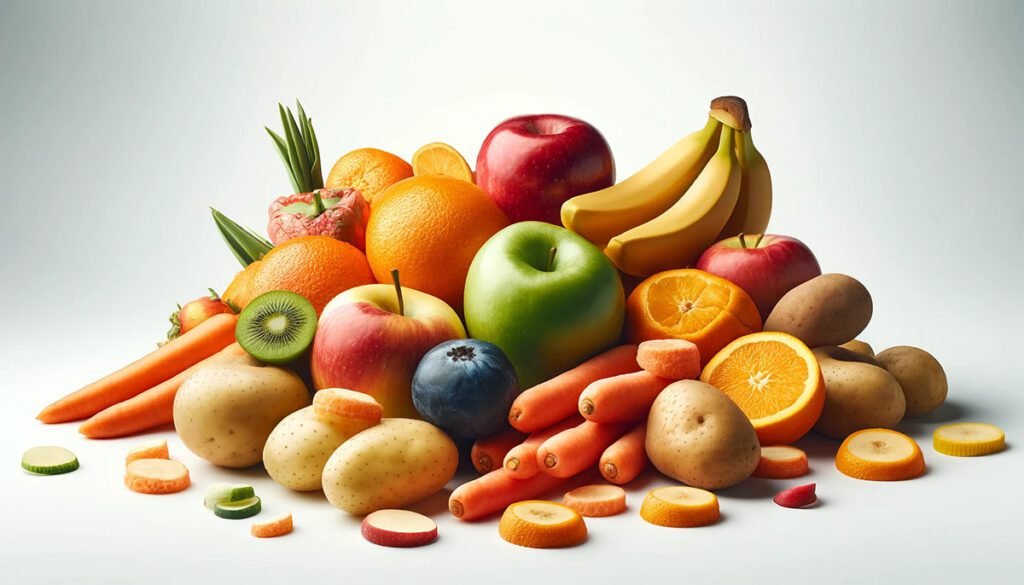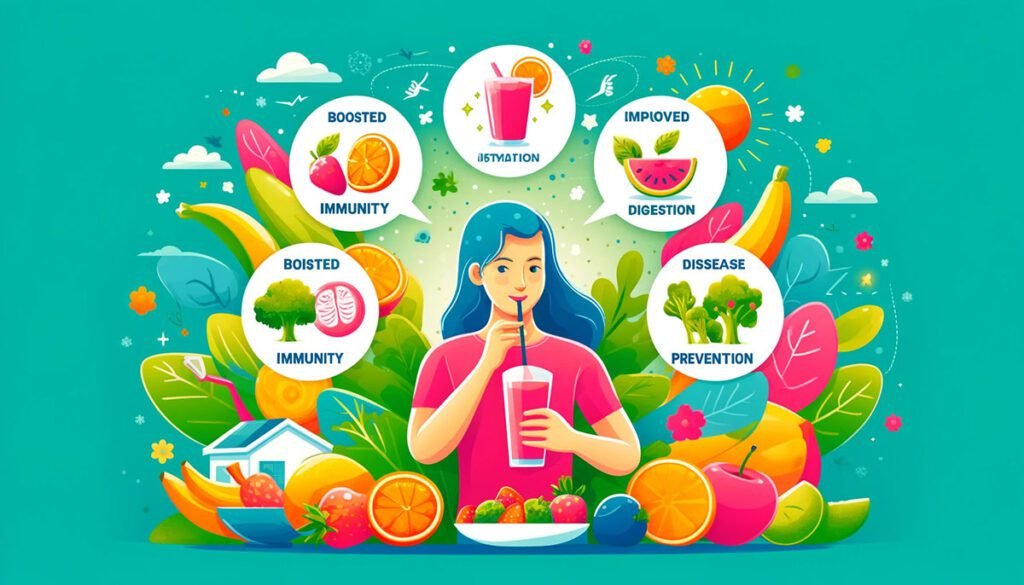Peels, often tossed aside as waste, hold within them a treasure trove of nutritional benefits waiting to be unlocked. In this article, we delve into the often-overlooked nutritional powerhouses that reside in fruit and vegetable peels and why incorporating them into your diet is a smart choice for your health and the environment.
1. Fiber-Rich Bounty
Fruit and vegetable peels are rich in dietary fiber, an essential nutrient for digestive health. Fiber aids in digestion, promotes regular bowel movements, and helps control blood sugar levels. By consuming peels, you’re increasing your fiber intake, which can contribute to a healthier gut and improved overall well-being.
2. Antioxidant Arsenal
Many peels are packed with antioxidants, compounds that combat oxidative stress and inflammation in the body. Citrus peels, for example, contain flavonoids and vitamin C, potent antioxidants that protect cells from damage. Similarly, the peels of apples and grapes boast polyphenols, which have been linked to numerous health benefits, including reduced risk of chronic diseases.
3. Nutrient Powerhouses
Contrary to popular belief, a significant portion of a fruit or vegetable’s nutrients is found in its peel. For instance, potato skins are rich in potassium, vitamin C, and B vitamins, while cucumber skins contain silica, beneficial for skin health. By consuming the peels, you’re maximizing your nutrient intake and reaping the full benefits of these wholesome foods.
4. Waste Reduction
Incorporating peels into your diet is not only beneficial for your health but also helps reduce food waste. By utilizing the entire fruit or vegetable, you’re minimizing organic matter that would otherwise end up in landfills or compost bins. This aligns with sustainable eating practices and contributes to efforts to reduce environmental impact.
5. Gut Health Booster
The fiber in fruit and vegetable peels acts as a prebiotic, feeding the beneficial bacteria in your gut microbiota. By nourishing these friendly microbes, fiber helps maintain a healthy balance of gut bacteria, which is crucial for digestion, immune function, and overall health. Consuming peels can thus promote a thriving gut environment and support digestive wellness.
6. Budget-Friendly Nutrition
Eating peels is not only good for your health and the environment but also for your wallet. Since peels are often discarded as waste, incorporating them into your meals allows you to maximize the value of your grocery purchases. You can enjoy the nutritional benefits of peels without spending extra money on supplements or specialty foods, making healthy eating more accessible and budget-friendly.
7. Culinary Versatility
Peels can be a versatile addition to your culinary repertoire, adding flavor, texture, and nutrition to a variety of dishes. Potato skins can be baked or roasted until crispy and served as a nutritious snack or side dish. Citrus peels can be zested and used to add bright, tangy flavor to dishes or infused into beverages for a refreshing twist. With a bit of creativity, peels can elevate your meals to new heights of flavor and nutrition.
8. Important Considerations
While eating peels can be beneficial, it’s crucial to wash them thoroughly to remove any dirt, pesticides, or contaminants. Opting for organic produce whenever possible can help minimize exposure to pesticide residues on the peels. Additionally, some individuals may be sensitive to certain fruit or vegetable peels, so it’s essential to listen to your body and make choices that work best for you.
THE NUTRITIONAL PROFILE OF FRUIT AND VEGETABLE PEELS

Overview of Nutrients
Fruit and vegetable peels are rich in vitamins, minerals, and antioxidants, often surpassing the nutritional value of the flesh. These nutrients are vital for maintaining good health and preventing chronic illnesses. Peels contain polyphenols and carotenoids, potent antioxidants that guard against oxidative stress and reduce inflammation.
Fiber Content
Peels are a great source of dietary fiber. Fiber is crucial for digestion, helping to ensure regular bowel movements and prevent constipation. It also aids in weight management by promoting satiety and lowering overall calorie intake. Additionally, fiber helps regulate blood sugar levels, which benefits people with diabetes.
Specific Examples
- Apple Peels: Rich in quercetin, an antioxidant with anti-inflammatory and antihistamine effects. High in fiber, they help lower cholesterol, contributing to heart health.
- Banana Peels: Loaded with potassium, essential for heart and muscle function. They also contain tryptophan, which improves mood and sleep.
- Orange Peels: Packed with vitamin C and flavonoids like tangerine and nobiletin, which have anticancer and antidiabetic properties. They also contain pectin, a fiber that supports digestion.
- Potato Peels: An excellent source of iron, potassium, and vitamin C, along with significant fiber, which aids digestion and supports a healthy gut microbiome.
By understanding the nutritional value of these peels, you can make informed choices about adding them to your diet for better health.
HEALTH BENEFITS OF CONSUMING PEELS

Digestive Health
Eating fruit and vegetable peels can greatly improve digestion due to their high fiber content. Fiber adds bulk to stool, promoting regular bowel movements and preventing constipation. It also acts as a prebiotic, feeding beneficial gut bacteria and supporting a healthy microbiome. This can improve nutrient absorption and reduce gastrointestinal issues like irritable bowel syndrome (IBS).
Immune System Boost
Vitamins and antioxidants in peels boost the immune system. Orange peels, for example, are rich in vitamin C, an antioxidant that enhances immune function by stimulating white blood cell production. Polyphenols and carotenoids in various peels protect cells from oxidative damage, lowering the risk of chronic illnesses and infections.
Disease Prevention
Peels are packed with compounds that help prevent diseases. Flavonoids in apple and citrus peels inhibit cancer cell growth and prevent tumors. High in potassium, banana peels can help reduce blood pressure and improve heart health. Peel antioxidants also have anti-inflammatory properties, which can help manage arthritis and reduce the risk of chronic inflammation-related diseases.
Case Studies/Scientific Research
Research supports the health benefits of consuming peels. A Journal of Agricultural and Food Chemistry study found fruit peels have higher antioxidant concentrations than pulp. Another study highlighted citrus peels’ anti-inflammatory and anticancer effects due to their high flavonoid content. These findings emphasize the importance of not discarding peels and incorporating them into the diet to maximize health benefits.
By understanding and utilizing the health benefits of fruit and vegetable peels, individuals can enhance their overall well-being and reduce the risk of various health conditions.
PRACTICAL TIPS FOR INCORPORATING PEELS INTO YOUR DIET

Preparation Methods
Start by thoroughly cleaning the peels to remove dirt, pesticides, or wax. A vegetable brush and running water can effectively clean most peels. Soak the produce in water and vinegar for a few minutes for tougher residues. Opt for organic produce to minimize pesticide exposure.
Culinary Uses
Peels can be used in many culinary ways to enhance flavor and nutrition. Here are some ideas:
- Smoothies: To boost fiber content without significantly changing the taste, add small pieces of apple, pear, or banana peels. Ensure the peels are finely chopped or blended well.
- Salads: Citrus peels, such as orange and lemon zest, can add a refreshing flavor to salads. Thinly slice or grate the peels over your salad for a zesty kick.
- Baking: Incorporate grated carrot or zucchini peels into muffins, cakes, or bread. This increases fiber and keeps baked goods moist.
Recipes
- Crispy Potato Peels: Toss cleaned potato peels with olive oil, salt, and pepper. Bake at 400°F (200°C) for 15-20 minutes until crispy. These make a tasty and nutritious snack.
- Citrus Peel Candy: Boil orange or lemon peels in water for 10 minutes. Drain and repeat to remove bitterness. Simmer the peels in sugar syrup until translucent. Allow them to dry, then roll them in sugar for a sweet treat.
- Vegetable Peel Broth: Collect peels from carrots, potatoes, and onions. Boil them in water with herbs and spices to create a flavorful broth for soups and stews.
The Overlooked Nutritional Powerhouses
Peels of many fruits and vegetables are rich in vitamins, minerals, fiber, and antioxidants, often containing higher nutrient concentrations than the flesh itself. For example, apple peels are a significant source of vitamins A and C, which are crucial for immune function and skin health. Potato skins contribute substantial amounts of potassium and fiber, aiding in heart health and digestion. By discarding these peels, many valuable nutrients are wasted.
Benefits of Consuming Organic Peels
- Enhanced Fiber Intake: Consuming organic peels can significantly increase one’s dietary fiber intake. This aids in digestion, helps regulate blood sugar levels, and can contribute to weight management by promoting a feeling of fullness.
- Rich in Antioxidants: The peels of many fruits and vegetables are high in antioxidants, which protect against cellular damage and reduce the risk of many diseases, including heart disease and certain cancers. For instance, the bright-colored peels of citrus fruits and apples are particularly rich in flavonoids and carotenoids, powerful antioxidants.
- Natural Detoxification: Certain peels, such as those from cucumbers and grapes, contain compounds that support the body’s natural detoxification processes. These substances help in cleansing the liver and flushing out toxins from the body.
- Cost-Effective Nutrition: Utilizing peels in cooking reduces food waste and provides a cost-effective way to boost nutrient intake without the need to purchase additional supplements or superfoods.
WellHealthOrganic.com: Eat Your Peels Unlocking the Nutritional Benefitsinto Your Diet
- Smoothies and Juices: Adding organic peels into smoothies and juices is an excellent way to enhance nutritional content. The peels of apples, pears, and kiwis blend well and provide additional fiber and flavor.
- Baked Goods: Grated citrus peels, like those from oranges and lemons, can be incorporated into cakes, muffins, and cookies, adding a zest that enhances flavor while enriching the food’s antioxidant levels.
- Homemade Chips: Thinly sliced potato or sweet potato peels can be tossed with a little olive oil and sea salt, then baked until crispy to create a healthy, fiber-rich snack.
- Vegetable Broths: Boiling vegetable peels in water can create a nutrient-rich broth that serves as an excellent base for soups and stews.
Safety Considerations When Consuming Peels
While the benefits of eating organic peels are numerous, it’s essential to consider safety:
- Choose Organic: To minimize exposure to pesticides and chemicals, it is preferable to use peels from organic produce. If organic produce is not available, washing fruits and vegetables with a baking soda solution can help remove some surface residues.
- Proper Cleaning: Thoroughly wash all fruits and vegetables to remove dirt and bacteria. A soft brush can be useful for scrubbing surfaces without damaging the peels.
- Edibility and Digestibility: Some peels, like those of avocados and pineapples, are not edible. Others, although edible, may be tough and difficult to digest. It’s important to know which peels are suitable for consumption and which are best avoided.
Educational Outreach and Awareness
 WellHealthOrganic.com: Eat Your Peels Unlocking the Nutritional Benefits is committed to raising awareness about the benefits of eating organic peels through its platform. It provides educational resources, recipes, and tips to help people make informed choices about their diets and reduce food waste.
WellHealthOrganic.com: Eat Your Peels Unlocking the Nutritional Benefits is committed to raising awareness about the benefits of eating organic peels through its platform. It provides educational resources, recipes, and tips to help people make informed choices about their diets and reduce food waste.
Expanding Culinary Horizons with Organic Peels
The culinary potential of organic peels is vast and versatile, challenging traditional perceptions and inspiring innovative kitchen practices. Beyond the health benefits, incorporating peels into daily cooking encourages creativity and introduces new textures and flavors to familiar dishes. WellHealthOrganic.com: Eat Your Peels Unlocking the Nutritional Benefits For culinary enthusiasts and home cooks, experimenting with peels can be an exciting way to elevate their cooking.
1. Zesting Up Flavors: WellHealthOrganic.com: Eat Your Peels Unlocking the Nutritional Benefits Citrus peels, from oranges, lemons, and limes, can be zested or grated to add a burst of flavor to marinades, dressings, and sauces. The zest not only imparts a tangy essence but also infuses dishes with vibrant aromatics that enhance the overall dining experience.
2. Creating Peel-Based Condiments: Peels can be transformed into delightful condiments. For example, watermelon rind can be pickled or turned into jam, offering a unique way to utilize the entire fruit. WellHealthOrganic.com: Eat Your Peels Unlocking the Nutritional Benefits Similarly, candied peels of citrus or apples provide a sweet treat that can be enjoyed on its own or used as a garnish for desserts.
3. Infusing Teas and Beverages: Adding dried fruit peels to teas or homemade beverages imbues them with subtle flavors and additional nutrients. Dried apple peels, cinnamon, and cloves can create a comforting herbal tea, perfect for chilly evenings.
4. Crafting Homemade Natural Dyes: Peels from vegetables like beets and onions provide natural colors, WellHealthOrganic.com: Eat Your Peels Unlocking the Nutritional Benefits which can be used in food decoration or even in crafting. These natural dyes are safe, eco-friendly, and provide a functional use for peels that might otherwise be discarded.
Conclusion
Fruit and vegetable peels are nutritional powerhouses that offer a myriad of health benefits, from fiber and antioxidants to essential vitamins and minerals. By embracing peels as a valuable part of your diet, you can improve your digestive health, reduce food waste, and support overall well-being. So, the next time you’re preparing fruits and vegetables, consider leaving the peeler in the drawer – your body and the planet will thank you.
